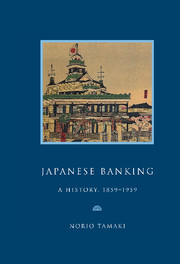Book contents
- Frontmatter
- Contents
- Preface
- Genealogy of leading Japanese banks, 1859–1959
- List of abbreviations
- Map
- Part I A bankrupt Shogunate, 1859–1868
- Part II The Meiji Restoration: monetary confusion and banking experiments, 1868–1881
- Part III Matsukata, the wizard of Japanese banking, 1881–1897; the Yokohama Specie Bank (1880) and the Bank of Japan (1882)
- Part IV The Japanese on the London money market, 1897–1911
- Historical background
- 13 The ‘Siamese twins’: Nichigin and Shokin, 1897–1911
- 14 Special banking, 1897–1911
- 15 Banking at the end of the Meiji era, 1900–1911
- 16 Banking and the securities market, 1897–1911
- Part V War, the Japanese boom years, 1911–1919
- Part VI Crisis and the road to war, 1919–1937
- Part VII Complete commitment, struggle and defeat, 1937–1945
- Part VIII American ‘democratisation’ and the search for growth, 1945–1959
- An extraordinary century, 1859–1959
- Appendices
- Notes
- Bibliography
- Index
14 - Special banking, 1897–1911
Published online by Cambridge University Press: 03 February 2010
- Frontmatter
- Contents
- Preface
- Genealogy of leading Japanese banks, 1859–1959
- List of abbreviations
- Map
- Part I A bankrupt Shogunate, 1859–1868
- Part II The Meiji Restoration: monetary confusion and banking experiments, 1868–1881
- Part III Matsukata, the wizard of Japanese banking, 1881–1897; the Yokohama Specie Bank (1880) and the Bank of Japan (1882)
- Part IV The Japanese on the London money market, 1897–1911
- Historical background
- 13 The ‘Siamese twins’: Nichigin and Shokin, 1897–1911
- 14 Special banking, 1897–1911
- 15 Banking at the end of the Meiji era, 1900–1911
- 16 Banking and the securities market, 1897–1911
- Part V War, the Japanese boom years, 1911–1919
- Part VI Crisis and the road to war, 1919–1937
- Part VII Complete commitment, struggle and defeat, 1937–1945
- Part VIII American ‘democratisation’ and the search for growth, 1945–1959
- An extraordinary century, 1859–1959
- Appendices
- Notes
- Bibliography
- Index
Summary
Long-term industrial financing, 1897–1911
The ‘special banking idea’ had in the late 1870s made its appearance in Matsukata's On Finance in the form of the proposed ‘hypothec bank’ which was to be commissioned to ‘specialise in mobilising capital, to promote production and encourage business progress’. It was the acceleration of industrialisation, which commenced in the latter half of the 1880s, which brought Matsukata's idea into prominence. The progress of both light and heavy industries, particularly the latter, demanded heavy investment. To respond positively the government was forced to mobilise any resources it could find. In the early 1880s the Ministry of Finance started to draw up a plan to set up an ‘industrial bank’. In 1895, after an interruption during the Sino-Japanese War, the plan was re-examined and a bill was laid before the Diet inaugurating the Hypothec Bank of Japan (Nihon Kangyo Ginko) under the Act of 1896.
The Act stipulated that the Hypothec Bank supply funds for the development and improvement of agriculture and manufacturing and that the government would appoint the management to direct the business conducted from the head office, the only office, based in Tokyo. The Hypothec Bank would be allowed to make advances to agricultural and industrial sectors on real properties redeemable within fifty years. Public institutions, such as prefectural and urban corporations, were allowed to borrow without pledging securities, but against their public creditworthiness. With ¥2.5 million paid-in capital, out of nominal capita of ¥10 million and with no right to accept deposits, the Hypothec Bank had to rely upon its issued debentures to secure lending resources.
- Type
- Chapter
- Information
- Japanese BankingA History, 1859–1959, pp. 98 - 103Publisher: Cambridge University PressPrint publication year: 1995



